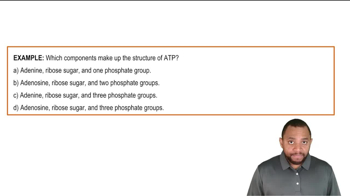Here are the essential concepts you must grasp in order to answer the question correctly.
ATP (Adenosine Triphosphate)
ATP is a nucleotide that serves as the primary energy carrier in cells. It consists of adenine, ribose, and three phosphate groups. The high-energy bonds between the phosphate groups can be broken to release energy, which is then used for various cellular processes, including muscle contraction, nerve impulse propagation, and biosynthesis.
Recommended video:
Adenosine Triphosphate (ATP) Example 2
Hydrolysis
Hydrolysis is a chemical reaction in which water is used to break down a compound. In the context of ATP, hydrolysis involves the cleavage of one of its phosphate bonds, resulting in ADP (Adenosine Diphosphate) and an inorganic phosphate. This reaction releases energy that can be harnessed by the cell for work.
Recommended video:
Acidic Hydrolysis Concept 1
Exergonic Reactions
Exergonic reactions are chemical processes that release energy. The hydrolysis of ATP is an exergonic reaction, as it releases energy that can be utilized by the cell. These reactions are crucial for driving endergonic processes, which require energy input, thereby maintaining cellular functions and homeostasis.
Recommended video:
Alcohol Reactions: Dehydration Reactions Concept 1
 Verified step by step guidance
Verified step by step guidance Verified Solution
Verified Solution



 1:46m
1:46m